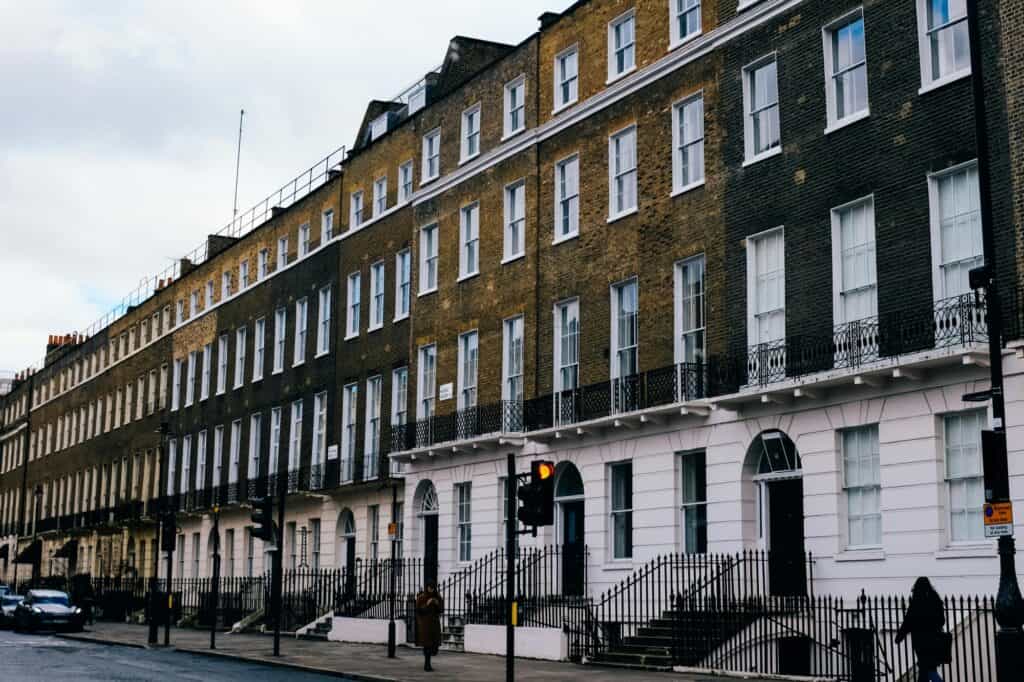Are you considering moving to South London and need affordable housing options when moving to South London? This article provides a comprehensive look at various schemes like social housing, intermediate housing, shared ownership, and the London Living Rent scheme. With detailed insights into each option, you’ll learn how to find a home that fits your budget and needs in South London.
Key Takeaways
- Affordable housing in South London includes social housing, intermediate housing, and shared ownership, catering to various income levels to enhance accessibility and stability.
- The London Living Rent scheme offers affordable rent based on one-third of local household income, enabling middle-income households to save for future home purchases over a minimum tenancy of three years.
- South London presents a range of affordable neighbourhoods, such as Barking and Dagenham and Bexley, which provide lower property prices alongside essential amenities and quality of life.
Understanding Affordable Housing in South London
Affordable housing in South London includes multiple schemes and options tailored to various income levels. These initiatives reduce housing costs and create pathways to homeownership for those who might be priced out of the market. These programs aim to make housing more accessible and ensure long-term stability for residents.
Social Housing
Social housing is a fundamental aspect of affordable housing in South London, primarily provided by the council to support individuals and families with very low incomes who might otherwise struggle to find stable, long-term housing. Rents are significantly lower than market rates, offering a crucial option for those in need and ensuring residents have legal protections and a stable living environment.
The sector includes various housing options, such as temporary accommodation for urgent needs and long-term homes for those facing financial difficulties. By maintaining lower rents and supporting rent arrears, social housing alleviates the financial burden on low-income households, allowing residents to focus on other life aspects like employment and education without the constant worry of housing costs.
Intermediate Housing
Intermediate housing bridges the gap between social housing and the open market, offering homes priced above social rent but below market rates. This type of housing assists those who earn too much to qualify for social housing but not enough to afford market rents. Properties often include one- and two-bedroom flats, some adapted for individuals with mobility difficulties.
A prevalent model in intermediate housing is shared ownership, where individuals can buy a share of a property – typically between 25% and 75% – and pay rent on the remaining portion, providing an affordable route to homeownership. This model allows residents to increase their share over time as their financial situation improves, eventually leading to full ownership.
Shared Ownership Properties
Shared ownership properties offer a unique pathway to homeownership for those unable to buy outright by allowing buyers to purchase a portion of the property, typically between 25% and 75%, while paying rent on the remaining share. This model reduces the initial financial burden, making it easier for individuals to enter the property market.
Over time, residents can increase their ownership share through a process known as ‘staircasing’ until they own the property outright. This gradual approach helps middle-income Londoners save for a full deposit, making homeownership more attainable and manageable.
London Living Rent Scheme
The London Living Rent scheme is a pivotal initiative aimed at helping middle-income Londoners save for a home purchase while enjoying affordable rents. This scheme enables tenants to buy all or a portion of the property within ten years. Rents set at one-third of the average local household income keep housing costs manageable, allowing tenants to save for a future home purchase.
One of the key benefits of the London Living Rent scheme is that it offers assured shorthold tenancy agreements for a minimum of three years and up to ten years. This approach not only helps tenants save for a deposit but also ensures that they can live comfortably and securely in their rented homes, making homeownership more attainable and manageable.
Eligibility Criteria
Applicants must meet specific criteria to qualify for the London Living Rent scheme. Household incomes must not exceed £67,000, although this cap may vary depending on the property and household circumstances. Additionally, applicants must either live or work in London, ensuring that the scheme benefits those who are already contributing to the city’s economy.
Proof of ability to pay rent and a deposit is required, assuring landlords that tenants can meet financial obligations. This eligibility assessment helps to ensure that the scheme supports those who genuinely need affordable housing while maintaining a fair and transparent application process.
Calculating Your Rent

Rents are calculated to be affordable, reflecting one-third of the average local household income. This method ensures that the rent remains within reach for middle-income earners, allowing them to save for a future home purchase. By linking rent to local household income and market-level rent, the scheme provides a fair and balanced approach to housing costs, making it easier for residents to manage their finances.
The primary goal of this rent calculation method is to help renters afford their housing while simultaneously saving money each month towards buying a home. This dual benefit makes the London Living Rent scheme a valuable option for those looking to transition from renting to homeownership in a sustainable and manageable way.
Available Properties
London Living Rent homes are located throughout South London, providing accessible options for various needs. These properties offer various bedroom sizes, catering to different family configurations and requirements. The availability of such homes is updated annually to reflect the current housing market and demand, ensuring that residents have access to the latest and most suitable London living rent homes.
Designed to be affordable homes, these homes make it easier for residents to find suitable housing in South London. The variety of properties available under this scheme highlights the commitment to providing diverse and accessible housing solutions for middle-income Londoners.
Affordable Renting Options
South London offers a variety of affordable renting options beyond the London Living Rent scheme, catering to different incomes and needs. Intermediate rent properties bridge the gap between social housing and market rates, while assured shorthold tenancies offer security and defined terms for private sector renters. These options ensure access to stable and affordable housing for residents, regardless of income level, meeting the diverse housing needs of South London residents.
Intermediate Rent Properties
Intermediate rent properties assist those who can’t afford market prices but don’t qualify for social housing. Priced between social rent and market rent, these homes are more accessible for middle-income earners. The rent for these properties can be set at up to 80 per cent of local market rent, ensuring that they remain affordable while providing a higher standard of living compared to social housing. These properties suit individuals and families in a transitional phase, seeking affordable housing while saving for a future home purchase.
Assured Shorthold Tenancies
Assured shorthold tenancies offer a secure, legally protected form of renting in the private sector. These tenancies usually have a fixed term, transitioning into a periodic tenancy that rolls monthly. This flexibility allows tenants to enjoy stability while having the option to move when needed.
A key benefit of assured shorthold tenancies is the legal protection they offer.
NOTE
Renters cannot be evicted without a valid legal reason, safeguarding their right to remain in the property during the tenancy period. This security is vital for those seeking long-term housing stability.
Affordable Homeownership Programs
Transitioning from renting to homeownership is significant, and South London offers programs to facilitate this process. The London Living Rent scheme helps tenants save for a future home purchase. Affordable rents in the scheme allow tenants to accumulate savings for a home deposit.
Help to Buy
The Help to Buy scheme assists first-time buyers in purchasing a home. Buyers can receive equity loans covering a portion of the home’s price, reducing the initial financial burden. This assistance facilitates entry into the property market, especially in high-cost areas like London.
Offering financial support through equity loans, the Help to Buy scheme bridges the gap between renting and homeownership. This program benefits those struggling to save for a full deposit, offering a more manageable route to homeownership.
Shared Ownership Basis
Shared ownership offers a flexible, affordable transition from renting to owning a home. Buyers purchase a share of the property – typically 25% to 75% – and pay rent on the remaining portion, reducing the initial cost of purchasing a home and making it more accessible. This model allows tenants of the London Living Rent scheme to gradually convert rent into equity. It makes homeownership a realistic goal through a process known as ‘staircasing’, where they can increase their ownership share over time until they own the property outright. This practical solution provides aspiring homeowners with a more flexible and financially manageable way to enter the property market.
Registering for Affordable Housing
Registering for affordable housing in South London involves meeting specific criteria set by local housing authorities, which vary by borough. The process typically requires providing personal details, financial information, and proof of eligibility to local authorities or housing associations to ensure housing options are allocated to those who need them most.

Share to Buy
Registering with Share to Buy gives potential homeowners access to a wide range of shared ownership opportunities through a comprehensive database of available properties. The platform simplifies the search for affordable housing by sending alerts about new listings and streamlining the registration process with an online form and necessary documentation to verify eligibility. This efficient system makes finding and purchasing a home more accessible, providing a clear pathway to homeownership for renters looking to own.
Local Authority Waiting Lists
Joining a local authority waiting list is crucial for those seeking affordable housing in South London. These lists are essential for accessing social and intermediate housing opportunities. Applicants must typically prove a local connection, such as having lived in the area for a certain number of years, ensuring housing is allocated to those with established community ties.
Being on a waiting list can significantly increase the chances of securing affordable housing, with many individuals obtaining a letting within a year. The system prioritises applicants based on needs and circumstances, ensuring those in urgent need receive assistance first. Understanding and navigating these waiting lists effectively can improve residents’ chances of finding affordable housing.
Navigating Eligibility and Prioritization
Affordable housing options in South London have specific criteria that vary by scheme. To apply, individuals must register with a local authority and demonstrate a priority need to move, often involving personal details, financial information, and proof of eligibility. Local authority housing eligibility is prioritised based on factors like homelessness status, tenancy length, and employment within the borough, using points-based systems to manage demand.
Meeting these criteria can increase applicants’ chances of securing a home. Once registered, applicants can bid on homes they qualify for or use a waiting list system, ensuring fair and efficient allocation of housing resources.
Income Requirements
Eligibility for affordable housing often requires a household income below £80,000. The specific income thresholds can vary depending on the scheme, typically ranging from a minimum of £30,000 to a maximum household income of about £90,000. These thresholds ensure that the housing is allocated to those who need it most, balancing affordability with access.
Intermediate rent properties, for example, are designed for individuals and families who earn too much to qualify for social housing but not enough to afford standard market rents. This income-based eligibility helps to bridge the gap for middle-income earners, providing them with more affordable housing options while they save for future homeownership.
Priority Need
Priority need status is a critical factor in determining eligibility for various affordable housing options. Factors such as homelessness status, length of current tenancy, and employment situation within the borough significantly influence this status. These criteria help authorities prioritize applicants based on their housing needs and urgency.
… individuals who are homeless or at risk of homelessness are often given higher priority.
For example, individuals who are homeless or at risk of homelessness are often given higher priority. Similarly, those with longer tenancies or stable employment within the borough may also receive higher prioritisation. Understanding these factors and how they affect eligibility can help applicants navigate the application process more effectively and improve their chances of securing affordable housing.
Affordable Neighbourhoods
South London boasts several neighbourhoods known for their affordability and quality of life. Barking and Dagenham, for instance, have the lowest average property prices in London, making it a viable option for affordable living. Bexley is another attractive area, offering low rental prices and abundant green spaces. These neighbourhoods provide a balanced mix of affordability and amenities, making them ideal for families and individuals alike.
Sutton and Croydon also stand out as affordable choices. Sutton offers some of the lowest rents in London along with strong educational performance in local schools. Croydon, undergoing significant regeneration efforts, presents promising opportunities for affordable housing alongside its low living costs.
These areas demonstrate that affordable living in South London is not only possible but also comes with a high quality of life.
Summary
Navigating the affordable housing landscape when relocating to South London involves understanding various options like social housing, intermediate rent properties, shared ownership, and the London Living Rent scheme. Each scheme caters to different income levels and housing needs, providing pathways to secure affordable housing and transition to homeownership. These programs aim to offer stability, affordability, and a route to homeownership for middle-income Londoners. By exploring these options and meeting eligibility criteria, residents can make informed decisions about their housing future, making affordable and stable housing in South London attainable.
Frequently Asked Questions
What is the London Living Rent scheme?
The London Living Rent scheme aims to assist middle-income Londoners in saving for a home purchase by offering affordable rental rates, set at one-third of local household incomes. This initiative addresses the needs of those struggling to afford housing in the capital.
How do I qualify for the London Living Rent scheme?
To qualify for the London Living Rent scheme, your household income must not exceed £67,000, and you must either live or work in London. Additionally, you must provide proof of your ability to pay rent and a deposit.
What are intermediate rent properties?
Intermediate rent properties are designed for individuals who earn too much to qualify for social housing yet cannot afford market rents, serving as a bridge between the two options. They typically offer more affordable rates than standard market pricing.
How does shared ownership work?
Shared ownership enables individuals to buy a percentage of a property, usually between 25% and 75%, while paying rent on the unowned portion, and it offers the flexibility to acquire additional shares over time.
What are the benefits of joining a local authority waiting list?
Joining a local authority waiting list enhances your likelihood of obtaining affordable housing, as it prioritises applicants according to their specific housing needs. This approach ultimately provides better access to suitable accommodation in your community.







